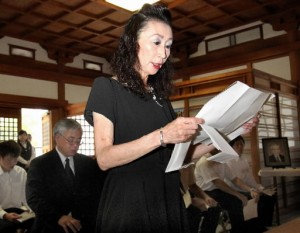Ceremony held to remember escape by Japanese POWs at World War II prison camp in Australia
Aug. 13, 2014
by Shinsaku Satao, Deputy Editorial Writer
On August 5, a group called the Australia Cowra Association, comprised of former Japanese soldiers, held a memorial ceremony at Nigitsu Shrine in Higashi Ward, Hiroshima to mark the 70th anniversary of the Cowra Breakout. The Cowra Breakout was a mass riot and escape during World War II by Japanese soldiers at a prison camp located in Cowra, in eastern Australia. It occurred on August 5, 1944.
In this incident, about 900 Japanese soldiers, brandishing weapons that included kitchen knives, broke free from the prison camp. In all, 231 Japanese soldiers died in shootings and suicides, and four Australian soldiers were also killed. It is believe that the breakout was a tragedy spurred by the military code of War Minister Hideki Tojo. This code pressured Japanese soldiers to commit suicide instead of suffering the “indignity” of becoming prisoners of war. In Australia, the Cowra Breakout is described in school textbooks.
Keiko Asada, 63, representing the families of the dead, expressed her condolences for the loss of life and said, “I hope that you, the spirits of the war dead now resting in a hill in Cowra, will contribute to peace in the world and the prosperity of Japan.” Students in a course taught by Professor Sadao Okamoto at the Hiroshima University of Economics offered a revised version of a book which contains interviews with Cowra survivors, conducted in 2001 and 2002.
A memorial ceremony was held in Cowra on the same day. Among the former POWs of the prison camp, only Teruo Murakami, 93, a resident of Tottori Prefecture attended the ceremony from the Japanese side and offered flowers at the cemetery there for the Japanese war dead. Seiichiro Tachibana, 93, a former prisoner of war and a resident of Oku-komyoen, a national sanatorium for leprosy patients in Okayama Prefecture, offered tanka poems to console the dead through visiting students from Sanyo Girls’ High School in Okayama Prefecture.
(Originally published on August 6, 2014)
On August 5, a group called the Australia Cowra Association, comprised of former Japanese soldiers, held a memorial ceremony at Nigitsu Shrine in Higashi Ward, Hiroshima to mark the 70th anniversary of the Cowra Breakout. The Cowra Breakout was a mass riot and escape during World War II by Japanese soldiers at a prison camp located in Cowra, in eastern Australia. It occurred on August 5, 1944.
In this incident, about 900 Japanese soldiers, brandishing weapons that included kitchen knives, broke free from the prison camp. In all, 231 Japanese soldiers died in shootings and suicides, and four Australian soldiers were also killed. It is believe that the breakout was a tragedy spurred by the military code of War Minister Hideki Tojo. This code pressured Japanese soldiers to commit suicide instead of suffering the “indignity” of becoming prisoners of war. In Australia, the Cowra Breakout is described in school textbooks.
Keiko Asada, 63, representing the families of the dead, expressed her condolences for the loss of life and said, “I hope that you, the spirits of the war dead now resting in a hill in Cowra, will contribute to peace in the world and the prosperity of Japan.” Students in a course taught by Professor Sadao Okamoto at the Hiroshima University of Economics offered a revised version of a book which contains interviews with Cowra survivors, conducted in 2001 and 2002.
A memorial ceremony was held in Cowra on the same day. Among the former POWs of the prison camp, only Teruo Murakami, 93, a resident of Tottori Prefecture attended the ceremony from the Japanese side and offered flowers at the cemetery there for the Japanese war dead. Seiichiro Tachibana, 93, a former prisoner of war and a resident of Oku-komyoen, a national sanatorium for leprosy patients in Okayama Prefecture, offered tanka poems to console the dead through visiting students from Sanyo Girls’ High School in Okayama Prefecture.
(Originally published on August 6, 2014)








